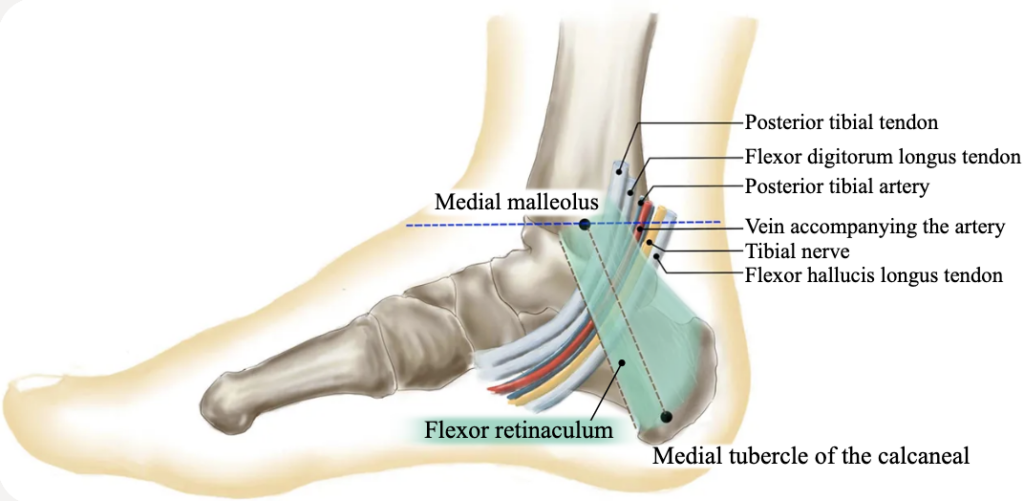Tarsal Tunnel Syndrome
Tarsal tunnel syndrome is similar to carpal tunnel, but in the foot. Pain or numbness on the bottom of the foot is caused by compression of a nerve - the tibial nerve - and its three branches, at the ankle.
The tarsal tunnel is located behind the inside ankle bone, and is where the tibial nerve branches into three nerves that provide sensation to the heel and the bottom of the foot. Similar to carpal tunnel syndrome in the wrist and hand, compression of these nerves can lead to numbness, pain, and balance issues.
Inside the first tunnel, the tibial nerve splits into three different segments. The calcaneal nerve goes to the heel, while the medial and lateral plantar nerves continue to the bottom of the foot. Each of these four nerves run through separate tight spaces, where they can be pinched, causing pain and/or numbness.

Diagnosis is based on pain history, a physical examination (with a Tinel sign – tapping on the nerve that produces ‘zingers’).
X-rays can rule out fractures, and MRIs can detect masses pressing on the nerves, but these tests are rarely needed.
Ultrasound can be used to assesses for other issues (tendon inflammation) in the area or for masses.
Nerve conduction studies (“EMG”) can confirm but not rule out tarsal tunnel syndrome – results may be normal in 50% of cases.
**These tests are rarely helpful more than a simple history and physical examination.
Symptoms of Tarsal Tunnel Syndrome are:
- Pain, numbness, and/or tingling in the ankle, heel and bottom of the foot.
- Swelling of the feet.
- The pain can worsen and spread after standing for long periods. The pain is worse with activity and is relieved by rest and elevation.
- Electric shock sensations.
- Pain radiating up into the leg, and down into the arch, heel, and toes.
- Hot and cold sensations in the feet.
- A feeling as though the feet do not have enough padding.
- Pain while driving.
- “Pins and needles”-type feeling.
It is often difficult to determine the exact cause of Tarsal Tunnel Syndrome, but anything that creates pressure in any or all of the four tunnels can cause it, including:
- Diabetes makes peripheral nerves swell, and susceptible to nerve compression.
- Tumors or cysts, bone spurs, inflammation of the tendon sheath, nerve ganglions, or swelling from a broken or sprained ankle.
- Varicose veins (that may or may not be visible) can also cause compression of the nerve.
- TTS is more common in athletes and other active people due to increased stress on this area.
- Flat feet may cause an increase in pressure in the tunnel region and this can cause nerve compression.
- Lower back problems may cause TTS symptoms. Back problems with the L4, L5 and S1 regions can cause a “Double Crush” issue: one nerve pinch in the lower back, and the second in the tarsal tunnel area.
- In some cases, TTS can have no identifiable cause.
Treatments typically include rest, physical therapy, immobilization with a walker boot, steroid injections, and orthotics.
Medications may include anti-inflammatories such as naproxen, or gabapentin.
If non-invasive treatment measures fail, tarsal tunnel release surgery may be recommended to decompress the area. This is a similar procedure to carpal tunnel release, in that it is outpatient surgery and relatively straightforward.
Doctors Brown and Hagan believe in several main points that maximize excellent results:
- Correct diagnosis. There are many other causes for pain in the area, and they must be considered.
- Complete release of all four nerves. The tarsal tunnel is different from the carpal tunnel – four nerves can each be compressed in different locations, and all must be released completely.
- Early mobilization. Putting patients in casts or boots after the operation only causes scar to form around the nerves and contribute to recurring pain. We promote early mobilization in a controlled fashion to prevent this common issue.
Nerve Surgery Helps Relieve Chronic Pain
The majority of patients with chronic pain report significant decreases or complete resolution of their pain following nerve surgery. Most patients describe the ‘nerve pain feelings’ are improved as soon as the following day. Discomfort from the operation is frequently described as a completely different sensation, which subsides in the next few weeks.